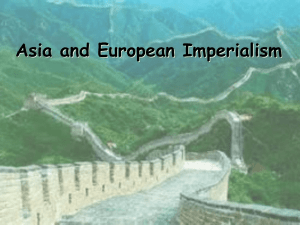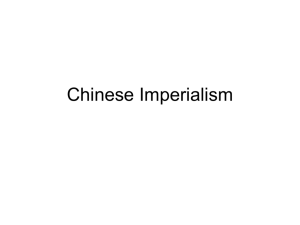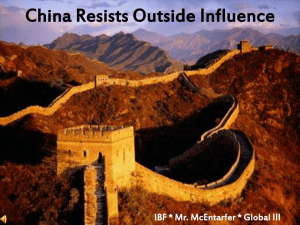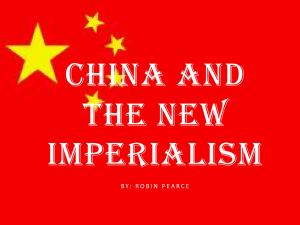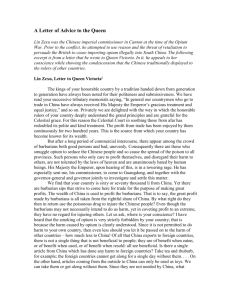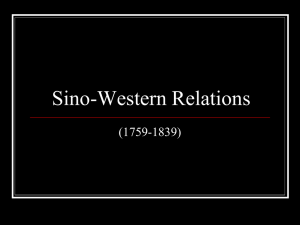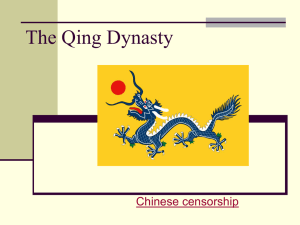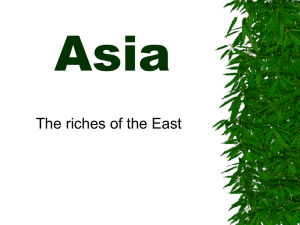China and Japan Encounter the Western World
advertisement
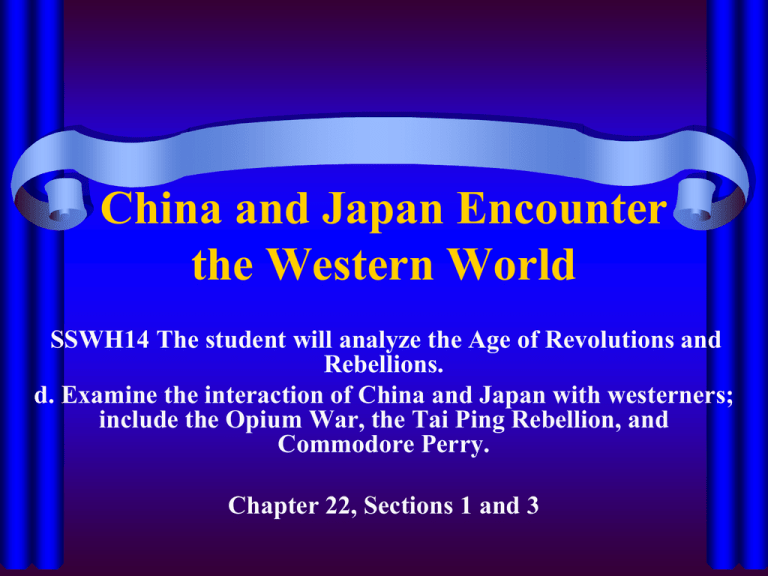
China and Japan Encounter the Western World SSWH14 The student will analyze the Age of Revolutions and Rebellions. d. Examine the interaction of China and Japan with westerners; include the Opium War, the Tai Ping Rebellion, and Commodore Perry. Chapter 22, Sections 1 and 3 Decline of the Qing Dynasty • In 1800, after a long period of peace & prosperity, the Qing were at the height of their power. • A little over a century later, humiliated & harassed by the Western powers, the Qing dynasty collapsed. • Reasons for decline: Intense external pressure applied by the modern West; Internal change including corruption, peasant unrest, & incompetence • Ships, guns, and ideas of foreigners highlighted the growing weaknesses and probably hastened the end. Background of the Opium War • By 1800, Europeans had been in contact with China for more than 200 years. • Restricted however to the island of Guangzhou • The British did not like this arrangement • British also imported more goods from China than they exported to China including tea, silk, and porcelain. • At first, they tried to negotiate. When that didn’t result, they turned to Opium. Background Continued… • Opium grown in northern India and shipped directly to Chinese markets. (India is a colony of Great Britain.) • Demand for opium (a highly addictive drug) in South China jumped dramatically. • Silver was flying out of Chinese hands and into the pockets of the British East India Company • British were not the first to trade opium; China had seen its dangerous qualities and made it illegal The Opium War • Government appealed to the Queen on moral grounds; British refused to stop Opium Trade • Chinese blockaded the port at Guangzhou to force traders to surrender the Opium • British responded with force starting the Opium War. The Opium War Continued… 1839 – 1842 • • Chinese were no match for the British • Treaty of Nanjing in 1842 – Chinese opened 5 coastal ports to British trade – Limited taxes on British goods – Chinese would pay the cost of the war – Chinese would give the British the island of Hong Kong • Marked the beginning of the establishment of Western influence in China. Tai Ping Rebellion • 1850 – 1864 • Failure of the Chinese government to deal with pressing internal economic problems led to a peasant revolt • Led by Hong Xiuquan, a Christian convert who viewed himself as a younger brother of Jesus Christ • Convinced God gave him the mission of destroying the Qing dynasty Tai Ping Rebellion Continued… • Joined by crowds of peasants, captured the town of Yongan, and proclaimed a new dynasty, the Heavenly Kingdom of Great Peace • Appealed to people because of its social reforms – Giving land to all peasants – Treating women as equals to men – Called for people to give up private possessions – Outlawed alcohol and tobacco – Eliminated foot binding Impact of Tai Ping Rebellion • Europeans came to the aid of the Qing dynasty after rebels seized Xianjing, the second largest city and massacred 25,000 people • Treaty of Tianjin in 1858 – Legalized Opium trade – Opened new ports – Surrendered Kowloon Peninsula • In 1860, British seized Beijing JAPANESE CONTACT WITH THE WEST An End to Isolation • By 1800, the Tokugawa shogunate had ruled the Japanese islands for 200 years • They drove out foreign traders & missionaries and isolated the country from virtually all contact with the outside world • To the Western powers, Japanese isolation was a challenge • West convinced global trade would benefit all nations • First foreign power to succeed was the U.S. U.S. Gain Entry to Japan • Summer of 1853: An American fleet of 4 warships under Commodore Matthew Perry arrive in Edo Bay (now Tokyo Bay) • Sought to bring a singular & isolated people into the family of civilized nations • Perry brought letter from President Millard Fillmore asking for better treatment of sailors shipwrecked on Japanese islands • Requested opening of foreign relations between the US and Japan About 6 Months Later… • Tokugawa Shogunate continue discussions on the pros and cons to American intervention. • Commodore Perry returns with a larger fleet for an answer. • After weeks of negotiations, Japan realized they were in no position to defend themselves against a foreign power and could not retain isolation with risking war. • • • • • Treaty of Kanagawa March 31, 1854 Return of shipwrecked American sailors Opening of two ports to Western traders Establishment of a U.S. consulate in Japan Friendly relations between the two countries ; marked the beginning of Western interaction with Japan Resistance to the New Order… • Highly unpopular in parts of Japan, particularly among the samurai in the southern territories • 1863: Sat-Cho alliance forced the shogun to promise to end relations with the west • Jan 1868: Armies attacked the shogun’s palace in Kyoto & proclaimed the authority of the emperor had been restored. • End of the Tokugawa Shogunate
